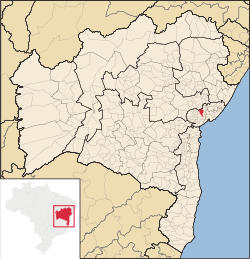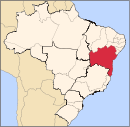|
Cachoeira
Cachoeira (Portuguese, meaning waterfall) is an inland municipality of Bahia, Brazil, on the Paraguaçu River. The town exports sugar, cotton, and tobacco and is a thriving commercial and industrial centre. The municipality contains 56% of the 10,074 hectares (24,890 acres) Baía do Iguape Marine Extractive Reserve, created in 2000.[3] São Félix is located directly across the Paraguaçu River from Cachoeira; it also borders the municipalities of Conceição da Feira, Santo Amaro, Saubara, Maragogipe, Governador Mangabeira, and Muritiba. HistoryThe area of present-day Cachoeira was home to numerous Amerindians prior to the colonial period. Paulo Dias Adorno and Afonso Rodrigues arrived in the region in 1531 from Portugal. They and their descendants entered into a century of conflict with the existing indigenous population, ultimately resulting in the expulsion of native Brazilians from the region. Mem de Sá, governor-general of the Portuguese colony of Brazil from 1557 to 1572, first attempted to expel the native population from Cachoeira in 1559. Álvaro Rodrigues Adorno, son of António Dias Adorno, arrived in 1595 and attempted peace settlements with the Amerindian population. Fighting continued between the two groups into the 17th century and hindered the settlement of the region by the Portuguese. Captain-General Gaspar Rodrigues Adorno attempted a final expulsion of the indigenous population in the early 17th century, and his son, João Rodrigues Adorno, rebuilt the a residential fort and a chapel in 1654. The chapel, Capela de Nossa Senhora da Ajuda (Chapel of Our Lady of Help), became the first in Cachoeira.[4][5][6] The settlement became known as Nossa Senhora do Rosário in 1674. It became the second town in Bahia under a Royal Charter of 1693 and was renamed the Vila de Nossa Senhora do Rosário do Porto da Cachoeira do Porto da Cachoeira do Paraguaçu. Because of its location on the Paraguaçu River, the town served as an important economic link between the interior of Bahia and its capital, Salvador; the city connected the agricultural lands of the Reconcavo and the interior sertão region.[5][6] Sugar cane farming and gold mining on the De Contas River (Rio de Contas) brought wealth to Cachoeira and resulted in an organized settlement on the Paraguaçu with numerous public buildings, churches, and urban residences.[5][6] Cachoeira became a center of the independence movement in the early 19th century. It was a center of the war of the Independence of Bahia and was elevated to city status under an imperial decree of March 13, 1873. The Companhia Central da Bahia—Imperial Central Railway Company Limited constructed a 25 kilometres (16 mi) extension from Feira de Santana to Cachoeira and São Félix in 1874. A foundation stone of a future railroad bridge was placed in Cachoeira on December 22, 1881. The engineers Frederico Merei and Affonso Glycerio da Cunha Maciel built the bridge, which was inaugurated on July 7, 1885. Pedro II of Brazil allowed his name on the bridge, which was named the Dom Pedro II Bridge, and the Imperial Arms were placed on a keystone of the bridge.[4] The worldwide 1846–1860 cholera pandemic reduced the population of Cachoeira and caused widespread social and economic disorder. The disease spread to Salvador in early 1855 and appeared in the Caquende and Pitanga neighborhoods of Cachoeira in August. It soon spread to both urban and rural parts of the town; 100 people died within the first ten days of the arrival of cholera in the Cachoeira. The epidemic disproportionately affected the town's slave population. Ultimately 3,000 died from the disease in the urban part of the city and 8,500 in outlying rural areas. Entire families were lost to cholera, the town was left with numerous orphans, several engenhos closed, and the economy of Cachoeira saw a steadily decline.[5][7] The city is now a center of tourism, is noted for its historic structures, and is a center of Candomblé. Population history
Notable people
Historic structuresCachoeira is home to numerous colonial-period historic structures, many designated as Brazilian national and Bahian state monuments. The historic center of Cachoeira was designated a national monument by the National Institute of Historic and Artistic Heritage (IPHAN). Cachoeira is also a noted center of historic terreiros of Candomblé, many of which have state or federal protection. Churches
Candomblé Terreiros
Residences
Urban buildings and structures
Sugar plantations
Gallery
References
External linksWikivoyage has a travel guide for Cachoeira.
|
||||||||||||||||||||||||||||||||||||||||||||||||||||||||||||||||||||||||||













